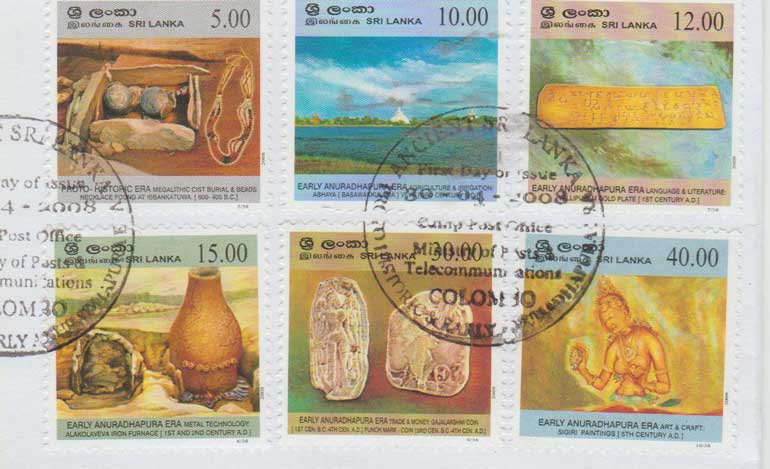Thursday Jan 01, 2026
Thursday Jan 01, 2026
Saturday, 2 April 2016 00:08 - - {{hitsCtrl.values.hits}}
 Anuradhapura, known to be the first capital of Sri Lanka, had gradually begun to emerge as a city in the Proto-Historic Age – the transition period ranging from 1000 to 600 BC. There is evidence to show that during this period, clay utensils had been manufactured and the people were competent to use iron while being engaged in agricultural activities.
Anuradhapura, known to be the first capital of Sri Lanka, had gradually begun to emerge as a city in the Proto-Historic Age – the transition period ranging from 1000 to 600 BC. There is evidence to show that during this period, clay utensils had been manufactured and the people were competent to use iron while being engaged in agricultural activities.
The existence of burial grounds has been found in several areas where clay utensils have been used. Excavations have been done at Ibbankatuwa, Yatigalpotta, Pomparippu and Gal sohon kanatta from where these have been unearthed.
Items collected from the burial ground at Ibbankattuwa are seen in the Rs. 4 stamp. Here the burial ground had been erected in the form of a stone trunk by placing four large stone plates. Clay pots containing parts of the human body and articles used by the person when he was living have bene placed inside and covered with a stone lid. Among the articles had been a chain of beads seen on the stamp. Archaeologists have concluded that this type of burial grounds belong to the period 750-400 BC.
It has been confirmed that from around 900 – 600 BC there were human settlements in Anuradhapura spread within an extent of 50 hectares. This was around the Mawatu Oya where mineral resources had been abundant along with water and fertile soil. A thick forest cover had shielded the area from possible foreign invasions. A provincial chieftain named Anuradha administered the area and when Pandukabhaya became king in 437 BC he moved to Anuradhapura making the city worthy of a king’s capital.
He built two big tanks – ‘Abhaya-vapi’ now known as Basawakkulama (Rs. 10 stamp) which is believed to be the first tank to be built in Sri Lanka, and ‘Jaya-veva’ to supply water to the paddy fields. Four suburbs were added to the city and sanitary services were organised with five hundred ‘candalas’ being appointed for cleaning the city, and many more to clean the sewers, to bury the dead and as watchers of the cemetery. A place of execution and torture had been built. He is also credited with having built a hospital and establishing boundaries of villages throughout the country.
“Thus emerged into political prominence a place which was to remain the seat of Sinhalese royalty for over a millennium, which in later times was adorned with numerous monuments of great architectural magnificence and religious sanctity, which witnessed the efflorescence of the culture of the Sinhalese and which, as a centre of art and religion, acquired a fame not restricted to the limits of this Island,” sums up Professor S Paranavitana in ‘A Concise History of Ceylon’ (1961).
The introduction of Buddhism to Sri Lanka during the reign of King Devanampiya Tissa (250-210 BC) is the moist significant event in the Early Anuradhapura period. The advent of Dravidians from South India and invading the Anuradhapura kingdom, the rise of King Dutugemunu (161-137 BC) who killed Elara, the Dravidian king who ruled for 44 years, building of dagobas and the resurgence of Buddhism are among later highlights of the era.
King Vasabha (65-109 CE) is credited of being the first of the great tank builders and his introduction of the system of canals helped agriculture to flourish. Inscriptions of the first to third centuries had made mention of 150 tanks and canals.
The Vallipural gold plate (Rs. 12 stamp) dating back to the period of King Vasabha had been found at the Vishnu kovil premises in Vallipuram, a village in the Vadamarachchi division of the Jaffna Peninsula. The small gold leaf (3½ inches in length and one inch wide) contains mini letters in four lines in Brahmi characters stating that minister Isigiriya who administered Nagadipa at the time had erected the Piyangukatisa Viharaya in a place called Bandakarantana.
Evidence of the use of metal technology during the first and second centuries has been proved by the iron melting furnaces found at the Alakolaveva area close to Sigiriya (Rs. 15 stamp).
The use of coins has been established by the copper coins belonging to 1st to 4th centuries of the Christian Era. The Lakhsmi coin (Rs 30 stamp) used in Sri Lanka at the time is considered unique in design with the portrait of Goddess Lakshmi being marked on its front and the ‘swastika ‘ on the reverse. The ‘swastika is featured on the front of the coin (right), which is two to two and a half centimetres in size. In these coins the ‘swastika’ had been used either with a horse of a tree.
Sigiriya, the abode of King Kassapa (477-495CE) has been described by historian C.W. Nicholas as “a stupendous engineering feat as well as a notable work of art: nothing comparable was attempted by any of his successors on the throne of Ceylon.” Referring to the 5th century frescoes of Sigiriya (Rs. 40 stamp) he says: “In ancient times the greater part of the western rock-face was covered with paintings. The style of frescoes is similar to that of contemporary paintings at the Ajanta caves in India and they are the oldest examples of figure painting in Ceylon. Of great academic interest are the graffiti on the mirror-like, glazed wall of the Gallery. After its abandonment on the death of Kassapa, Sigiriya attracted numerous visitors of all grades of society for nearly six centuries and many of the more enlightened of these sightseers inscribed verses on the polished wall.”
(Concise History of Ceylon)
(Next: Late-Anuradhapura Era.)